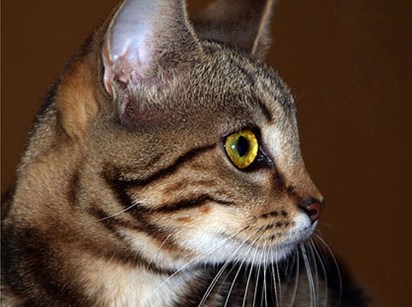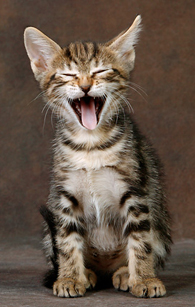Sokoke
This exotic cat originates from the Sokoke district of eastern Kenya, but was further developed in Denmark. Its unusual coat pattern, which displays a “wood grain” effect, is a crowd-pleaser at cat shows, and its friendly nature is perfect for those seeking an animal companion.



PHYSICAL CHARACTERISTICS
The Sokoke Forest Cat has a wild look. A medium-sized cat, its body is graceful and slim but muscular. The rear legs are higher than the forelegs and its tail is pointed and tapered. The Sokoke Forest Cat also has a relatively small head with almond-shaped eyes that are usually amber to light green in color.
The most eye-catching feature of the Sokoke Forest Cat, however, is its unusual coat, which is lustrous, short, and body-hugging. The coat pattern, dubbed “African Tabby,” resembles the Blotched Tabby with a “wood grain” look. The color of the coat ranges from warm light brown to deep chestnut brown.
PERSONALITY AND TEMPERAMENT
Despite having come from the wild, the Sokoke Forest Cat can be tamed easily. It does not, however, desperately seek attention or enjoy being cuddled in your lap. Instead, this friendly cat displays its affection for its owner by following him or her around the house. A born chatterbox, it can carry on a conversation for hours. In fact, this independent cat can itself easily with the simplest of items or games. The Sokoke Forest Cat is also an agile and lively breed, which is alert at all times. If threatened, the cat will not hesitate to use their teeth and claws.
CARE
Because the Sokoke Forest Cat sheds little hair, it requires little grooming - once a week with a grooming glove or brush is sufficient. Bathing the cat is also easy. Unlike other breeds of cat, the Sokoke Forest Cat can swim and is less afraid of water.
HEALTH
Though sturdy, the Sokoke Forest Cat is vulnerable to disease. Pay extra attention to the cat's ears, as excess dirt can lead to ear mite infections. Additionally, its paws must be frequently examined for cuts and bruises.
HISTORY AND BACKGROUND
Compared to other breeds of cat, the Sokoke Forest Cat is relatively young. The story of its rise began in 1977, when a cat and its litter was discovered near the edge of the forest in the Sokoke district of eastern Kenya. Fortunately, the “queen” had taken refuge in a hollow on a tract of land owned by wildlife artist Jeni Slater.
After inspecting the family, Slater realized all the cats had unusual markings, the kind which had never been seen before. She took a male and female kitten home with her, tamed them, and later started breeding from them.
The ease with which they became tame suggests they were formerly domestic cats that had gone wild, rather than true wild cats. However, there are several other theories as to where this “queen” may have come from, including as a result of mating a wild cat with a Kenyan domestic cat, or due to a spontaneous mutation among the simpler domestic cat.
Whatever the case, when Danish cat lover Gloria Moldrup paid a visit to Jeni Slater, she acquired a pair of these cats. Once these unusual cats reached Denmark they were displayed at the JYYRAK Show at Odense. Moldrup's unconventional cats quickly became popular amongst local cat fanciers, and laid the foundation of the breed in Europe.